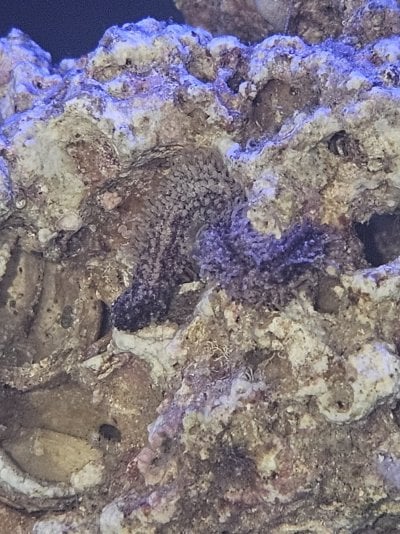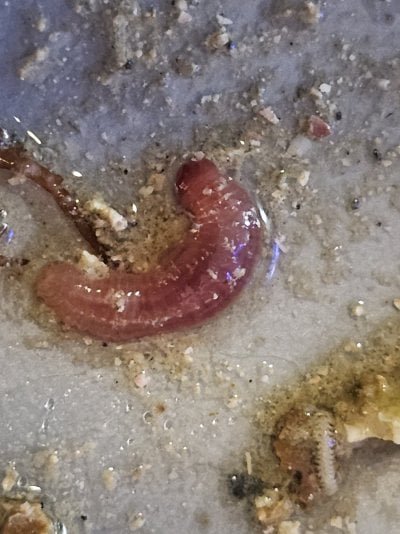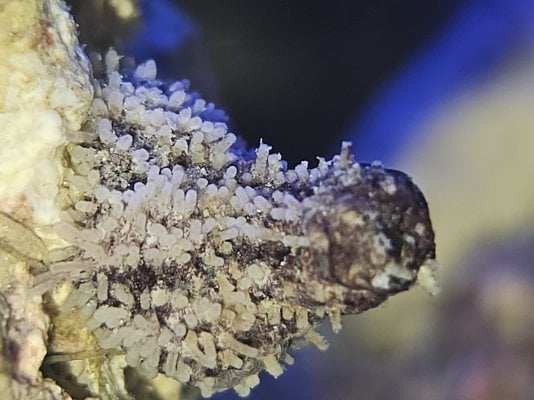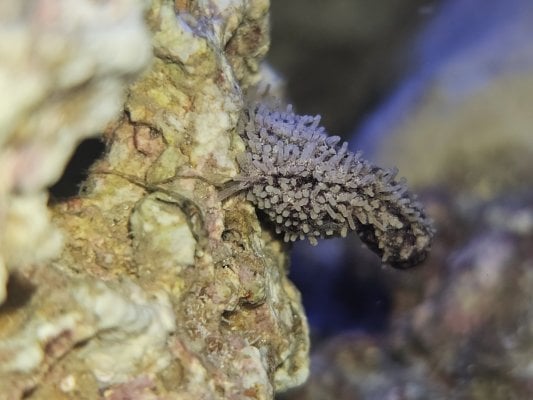Navigation
Install the app
How to install the app on iOS
Follow along with the video below to see how to install our site as a web app on your home screen.
Note: This feature may not be available in some browsers.
More options
You are using an out of date browser. It may not display this or other websites correctly.
You should upgrade or use an alternative browser.
You should upgrade or use an alternative browser.
Sea Cucumber, Yay or nay?
- Thread starter Generator
- Start date
- Tagged users None
Top looks like a sea hare but could be wrong. Personally looking to add those. Trying to avoid cucumber being I know little of them but with this thread that might change.
Do sea hare have the same capacity to poison a tank?Top looks like a sea hare but could be wrong. Personally looking to add those. Trying to avoid cucumber being I know little of them but with this thread that might change.
Been researching that and seems their poison based on algae eaten and as such not necessarily toxic to the tank.Do sea hare have the same capacity to poison a tank?
Check this out.
In order here:Do I need to remove them when opportunity presents? Do all of them have the capacity to poison the tank? If so, are these too small to worry about at the moment.
-No, you don't need to remove them, though you can if you want (depending on your fish/invert stocking, you may want to); some people would want to because:
-Yes, all of them technically have the capacity to poison a tank, but cases of that actually happening are incredibly rare (statistical outliers), and some species are much less likely to poison a tank than others (sand-sifting kinds are generally safer than filter-feeding kinds)
-Possibly, but probably not; regardless, it's always best to assume that the cukes are capable of poisoning the tank to be safe.
For what it's worth, I've only heard of three cases so far of the dreaded "cuke nuke" where the sea cucumber poisons a tank (two of the cases are linked in the first quote below), and a lot of people do keep these, but it's good to be aware of the risk and to have plans in place to deal with the issue if it arises.
The below is a lot of info, but - basically - chances are good you won't have any issues with the cukes if the tank is a safe environment for them. If you want feeding advice, I can offer that too, but this is already a lot of info, so I'd rather cover that in a separate post:
Yeah, I've only heard of a couple of instances where a "cuke nuke" actually took place despite knowing multiple instances of cucumbers ejecting either a toxic fluid, their organs, or their cuvierian tubules, so it's definitely not a common event (at least not with sand sifting species). That said, keep in mind that the toxicity varies from one species to the next, and some species are more toxic in certain ways (some are more toxic when they expel toxins in some way, others contain more toxin in their body wall, etc.), and various circumstances (such as water volume, skimmers, running carbon or not, etc.) about the aquarium they're in can determine how much harm the toxin causes.
Personally, I'd say they generally seem pretty safe, but you need to be aware of the (relatively low) risk and have a plan in place to handle it if things go awry.
The cuke nukings:
An instance of ejecting a fluid (nothing seemed to have been harmed in the tank, but this stuff is reportedly toxic):
EMERGENCY - Anemone Toxin / Sea Cucumber Toxin
Hi! Unfortunately, this morning I woke up to all my fish deceased, the sea cucumber and anemone also dead, with some gooey like slime stuck in my return pump. All of my crabs and snails are alive including my pom-pom, Anemone Crab and my Conchs, critters I thought to be extremely sensitive...www.reef2reef.com

EMERGENCY - New Black Sea Cucumber Red Stuff
Hey all, I recently got a black sea cucumber. I acclimated it with the drip method, and after a day it is now expelling this stuff. I've ready a lot about the toxicity, but I'm not sure if I should pull him now or not. All my SPS and fish seem to be fine.www.reef2reef.com
I'd recommend being aware that sea cucumbers can release a fish poison when extremely stressed, but as long as there's nothing harassing them in the tank, they should be totally fine (so just don't get a fish or invert known to eat or pester sea cucumbers and you should be fine; if you're concerned about it, my suggestion is to run carbon/keep carbon on hand to run, and keep mixed saltwater ready to be used for a water change just in case). I have more info on the toxin if you'd like.
I know they may sound scary, but sea cucumbers are usually totally harmless/beneficial.
Whether or not you decide to keep them is up to you - some people like them, others think they’re not worth the risk. To help you decide if they might be worth the risk, here’s a sizable info dump.
If you keep them fed and have your tank set up to hold them (i.e. make sure they can’t get sucked into powerheads/filters, make sure they can’t torch themselves on your heater, etc.), then they are typically beneficial.
However, from what I’ve read, it seems literally all sea cucumber (medusa worms included) do have the toxins you’re concerned about to some degree or another. The part that’s hard is that how much toxin the cuke contains and how likely a cuke is to release those toxins varies from species to species. Some species are substantially more prone to releasing the toxins than others, and some release a good deal more of the toxin than others. An important note here, the toxin of sea cucumbers (holothurin) is an ichthyotoxin (it primarily affects fish, though in high enough quantities it can affect other things like inverts and people too), so if the cucumber does release its toxin into the tank, the inverts might be fine. For more info, here’s a post I made referencing and expounding upon another of my posts on the subject from a while ago:
As mentioned, many sea cucumbers will release toxins when stressed/dying, so it's important to keep them happy and to be prepared to deal with that situation should it arise (i.e. be prepared to do an emergency water change, add carbon, transfer livestock to a hospital tank, etc.) - some cukes are highly toxic, some only mildly, some release toxin when stressed, others only release it once their corpse starts to decay, etc. so the risk varies a lot depending on the species, but unless they're one of the highly toxic species (like Sea Apples) it's not usually too big of a concern. Plus, many species will give warnings that they're dying/stressed, so sometimes people are able to get a heads up that they need to remove them (see my quote below for more info).
TLDR; nem guards are good idea for sea cucumbers.ISpeakForTheSeas said:
Some sea cucumbers like to just pick a spot and stay there, so it might just decide not to move. Given that you said this one started real small and kept growing, it's possible you just had all three come in at the same time, possibly from the same batch of baby sea cucumbers. If that's the case you either could have just missed them because they were so small, or the other two may have just moved over there because the conditions there are more favorable for their larger size than the previous area they were in.
Regardless, most sea cucumbers are generally safe in reef tanks (not much tries to eat them, so generally you don't need to worry about them getting overly stressed), but you should probably make sure your equipment is sea cucumber safe (i.e. you want to make sure they can't get pureed by going into one of your powerheads or something), and - as was mentioned above - they can release toxins when they die, so you'll want to keep an eye out for that. A lot of sea cucumbers will give you some sort of warning before they die (such as contracting to look short and squat - a defense mechanism/sign of extreme distress that they use to try and escape predators/death - or ejecting a cloud of toxins - because of how this actually works, the cucumber generally dies after releasing the toxins), and some of them, as long as they don't get hyper distressed, (as I understand it) won't intentionally release toxins in your tank - they just die like a normal animal, so as long as you remove the body fast enough, it won't poison your tank.
On the off chance that they do decide to release toxins into your tank, if you catch it early enough, you can run carbon, do a big water change, and (if necessary) transfer your livestock to another tank. I would strongly recommend using protective equipment in this case as some sea cucumbers when they release toxins can be dangerous to humans, but, ideally you wouldn't need to worry about it. Ideally, you'd just remove the cucumber either soon before or soon after it dies (the people I've talked to said they didn't need to run carbon or anything when theirs died in their tank, so as long as you catch it before the body starts degrading you should pretty much be fine as I understand it).
Lots of scary info there, but generally sea cucumbers are safe to keep, and as long as they are physically safe from harm in your tank the chances of them "cuke nuking" it by releasing toxins into your tank are very slim.
Hope this helps!
It is a new tank. They came in on the live rock. I have live sand coming end of the week. I thought of taking them to my LFS if they are detrimental to the tank, I also don't want them to die from lack of food. Right now, the two I can see are pretty snugged up on some rocks. I was hoping to get an easier, less stressful opportunity to snag them if needed.If you have a fresh tank then remove them - there would be nothing for them to feed on.
Could feed them nori which will be my approach if lucky enough some hitched a ride on some rock.If you have a fresh tank then remove them - there would be nothing for them to feed on.
Seeing some of the new posts, I'll just tack it on here:If you want feeding advice, I can offer that too,
Some general feeding info for sea cucumbers, addressing filter-feeders first:
Now for sand-sifting cukes:there are basically two types of sea cucumbers: filter feeders and sand-sifters. The filter feeders need fed things like Isochrysis galbana (T-Iso), Tetraselmis sp., Thalassiosira sp., and Chaetoceros sp., while the sand-sifters should do find on pretty much any tiny/ground up food (pellets, frozen, etc.) with plenty of greens (phytoplankton/microalgae and/or macroalgae) added in - you just want to make sure the mix reaches the sand so that they could sift the sand to get the food; you could do this by using sinking feeds, or by mixing the feed in with some sand in a dish that you take out and put in to the tank at feeding time for the cuke:
With regards to the sediment feeding cucumbers, as mentioned, you can ghost feed the tank and they'll do just fine on that. For example, the Chocolate Chip Sea Cucumber (Isostichopus badionotus) has been bred in captivity on the following diets*:
"Two feeding protocols were tested: In the first year, the broodstock were fed with commercial tilapia and rabbit feed which was ground, supplemented with Spirulina powder, and blended with disinfected beach sand (30g food/kg sand). In the second year, the food was changed to a mixture of ground Ulva sp., Sargassum sp., and Macrocystis sp. meals (Baja Kelp, Ensenanada, B.C., Mexico) blended with disinfected beach sand (30g algae mixture/kg sand). The food was changed every third day to prevent fungus formation."
I don't remember the other species I've looked at at the moment, but, generally speaking, sand sifting sea cucumbers are not picky about what they eat (though the food likely needs to be relatively decently sized so as to fit in with the sediment they're sifting - for example, the food they fed to the juvenile sea cucumbers when they reached 3 cm in the study above was sieved 55 at microns). Some easy foods you could offer that should work even for smaller cucumber species would be things like TDO Chromaboost Type A and Spirulina powder like used in the study I referenced.
I've seen a removable dish of sand mixed with food used successfully in sea cucumber aquaculture,
Edit: The study referenced in the quote above:
https://onlinelibrary.wiley.com/doi/epdf/10.1111/jwas.12061
I'd try to get the food in the ~100-500 micron range, preferably closer to 50-200 microns (especially if the cuke isn't full grown). I know foods in that size can be hard to come by - Otohime and TDO Chromaboost offer pellets in that general range, and they're amongst the best pellet feeds on the market (no pellets on the market for hobbyists are as good as fresh food or a high quality frozen food).
I don't know the Florida Sea Cucumber's (Holothuria floridana's) preferred food size, but most other species in the genus prefer feeds that range from ~60-200 microns, with a handful of exceptions that prefer either medium-small foods (~200-600 microns) or huge foods (~2,000-3,500 microns).*
Pretty much every pellet on the market will contain grains of some variety (almost always to act as a binding agent to hold the pellets together; sometimes also to provide enough calories/energy to make the food an efficient feed) - if used in small enough quantities, it's not really an issue, but when there's too much grain (too many carbohydrates) it can cause some nutrition issues.
For the spirulina, you can buy spirulina powder which will probably be closer to the right size for the cuke.
*Source:
Sophistication in a seemingly simple creature: a review of wild holothurian nutrition in marine ecosystems - PMC
Holothurians are marine invertebrates that are among the most widespread benthic megafauna communities by both biomass and abundance in shallow‐water and deep‐sea ecosystems, their functions supporting important ecological services worldwide. ...www.ncbi.nlm.nih.gov
Wow, lots of great info! Thank you!In order here:
-No, you don't need to remove them, though you can if you want (depending on your fish/invert stocking, you may want to); some people would want to because:
-Yes, all of them technically have the capacity to poison a tank, but cases of that actually happening are incredibly rare (statistical outliers), and some species are much less likely to poison a tank than others (sand-sifting kinds are generally safer than filter-feeding kinds)
-Possibly, but probably not; regardless, it's always best to assume that the cukes are capable of poisoning the tank to be safe.
For what it's worth, I've only heard of three cases so far of the dreaded "cuke nuke" where the sea cucumber poisons a tank (two of the cases are linked in the first quote below), and a lot of people do keep these, but it's good to be aware of the risk and to have plans in place to deal with the issue if it arises.
The below is a lot of info, but - basically - chances are good you won't have any issues with the cukes if the tank is a safe environment for them. If you want feeding advice, I can offer that too, but this is already a lot of info, so I'd rather cover that in a separate post:
I do have some nori I could try.Could feed them nori which will be my approach if lucky enough some hitched a ride on some rock.
Right now it looks like whatever is in there might have an opening at either end vs an opening and a face. Would be nice to not have to worry about either being a potential time bomb.Been researching that and seems their poison based on algae eaten and as such not necessarily toxic to the tank.
Check this out.
Hard to tell from your pic what is. Persisting an LFS that has then and go see them in person. You know when you’re looking at a cucumber vs a slugRight now it looks like whatever is in there might have an opening at either end vs an opening and a face. Would be nice to not have to worry about either being a potential time bomb.
I’m speaking specifically to it being a sea hare as I don’t think cucumbers eat algae. Would be one way I guess to test it. Place it at night on the substrate and check on it periodically.I do have some nori I could try.
I've seen big cucumbers when I used to live in the keys. I've not seen them this little but it's what it looks like.Hard to tell from your pic what is. Persisting an LFS that has then and go see them in person. You know when you’re looking at a cucumber vs a slug
Attachments
Yeah, they're definitely cukes (though I agree the first pic was tough to make out).I've seen big cucumbers when I used to live in the keys. I've not seen them this little but it's what it looks like.
Could that be a nudibranchI've seen big cucumbers when I used to live in the keys. I've not seen them this little but it's what it looks like.
Could that be a nudibranchW
I had the thought for a brief moment. More because I wanted it to be than anything elseCould that be a nudibranch
They're most likely Phyllophorid cucumbers, probably a Thyone species, but I can't say for sure.
Some nudibranchs do look fairly similar, but they tend to flatten out at the ends instead of staying round, and you can see the signs of pentradial symmetry on the cukes (shown by the dark lines between the white bumps).
Some nudibranchs do look fairly similar, but they tend to flatten out at the ends instead of staying round, and you can see the signs of pentradial symmetry on the cukes (shown by the dark lines between the white bumps).
Could feed them nori which will be my approach if lucky enough some hitched a ride on some rock.
Sea cucumbers eating nori???
Similar threads
- Replies
- 11
- Views
- 244
- Replies
- 5
- Views
- 325
- Replies
- 6
- Views
- 187























